Nestled in the diverse landscapes of Iwate Prefecture, the towns of Tono, Kamaishi, and Miyako each offer a unique journey into Japan’s rich culture and natural beauty. In Tono, folklore comes alive through tales of kappa and traditional life. Kamaishi blends industrial heritage with resilience, offering ocean views and historical depth. Miyako enchants with its dramatic coastline, fresh seafood, and serene beaches like Jōdogahama.
From sacred shrines to scenic boat rides, this region invites you to explore the legends, landscapes, and local flavors that define northern Japan.
Discover the Folklore and Charm of Tono, Iwate
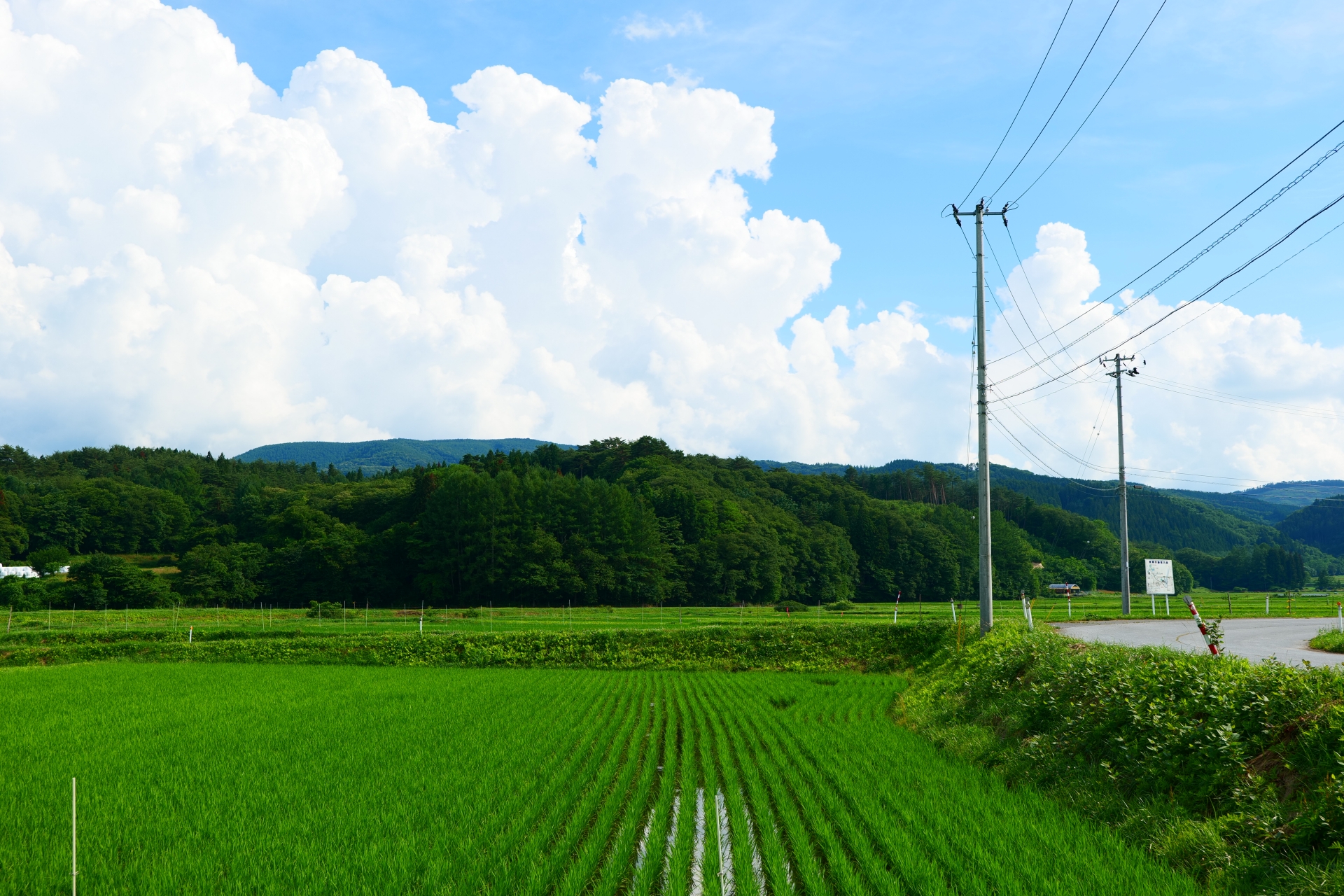
Tono is a town where myths and nature come alive. Known as the “Home of Folklore,” it’s filled with legends of kappa and house spirits, traditional rural landscapes, and heartfelt hospitality. Enjoy seasonal beauty, craft beer made with local hops, and performances of traditional arts passed down for generations. In Tōno, every visit feels like stepping into a living storybook.
Fukusenji Temple 福泉寺
Fukusenji is a Shingon Buddhist temple established in 1912 (the first year of the Taishō era) that houses Japan’s largest wooden Kannon statue, standing an impressive 17 meters tall. In addition to serving as the sole site of both the Shin-Saigoku Thirty-Three Kannon Pilgrimage and the Shin-Shikoku Eighty-Eight Temple Pilgrimage in Iwate Prefecture, Fukusenji features striking architectural landmarks, including a grand multi-tiered pagoda and a five-story pagoda.
The temple’s grounds are renowned for their natural beauty, offering breathtaking displays of cherry blossoms and azaleas in spring and vivid autumn foliage later in the year. Visitors can also witness the awe-inspiring Fukutoku Kannon, painstakingly carved over 12 years from a single 1,200-year-old pine, which was brought to the temple with the help of devoted believers. This fusion of rich history, sacred art, and seasonal splendor makes Fukusenji a truly memorable destination for travelers.
Denderano デンデラ野
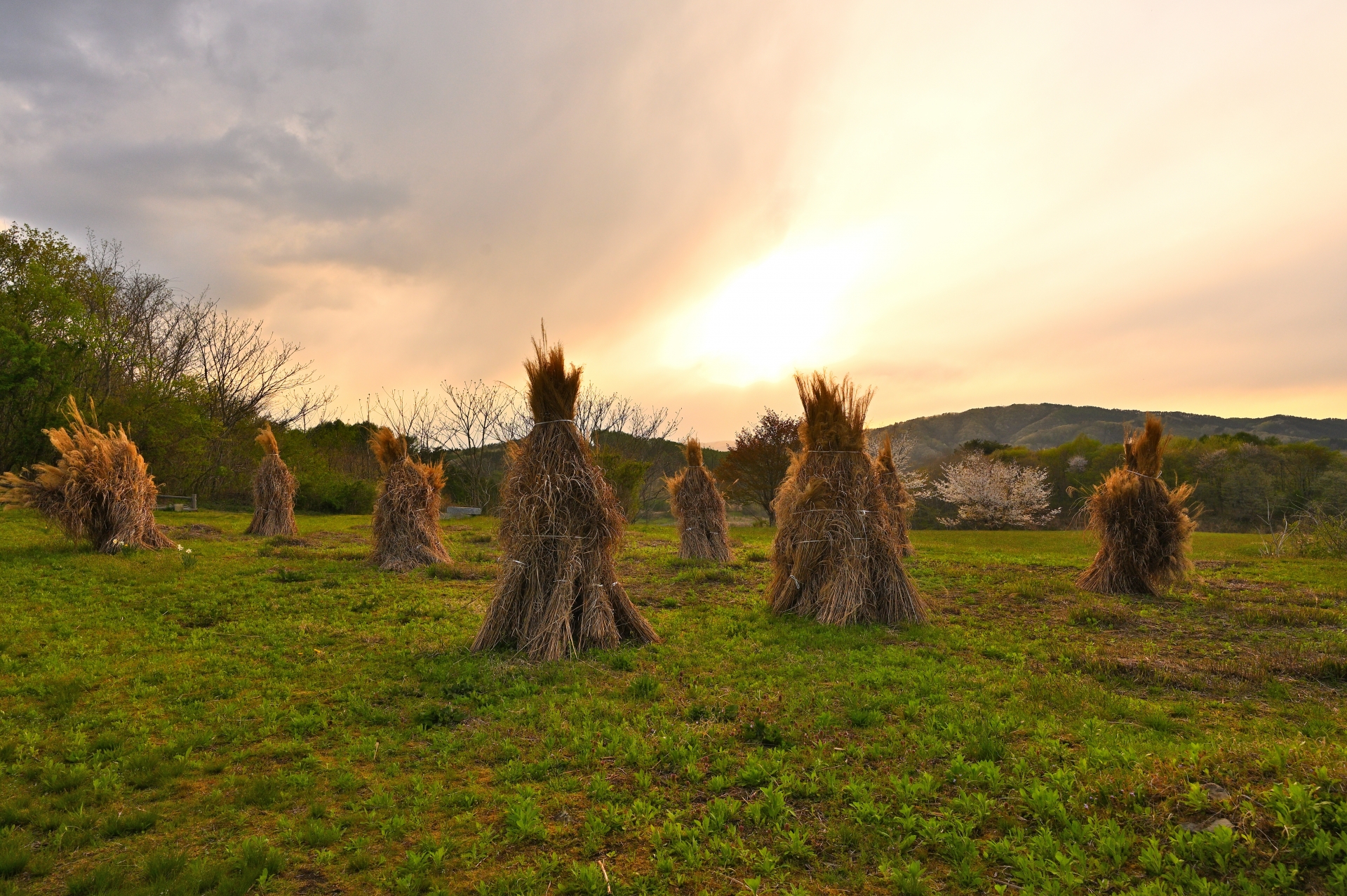
Denderano is a gently rolling hillside in the Yamaguchi region of Tono, renowned as the setting of the “Ubaste” legend—the story that elderly individuals over 60 were once sent here to live self-sufficiently. Originally called Rendaino, the name evolved into Denderano over time. Featured in the classic folklore collection Tono Monogatari, this area was also said to be a place where spirits of the departed passed through. Today, it has transformed into a peaceful landscape of farmlands and distant homesteads, offering visitors a glimpse into traditional rural life. A replica dwelling, built in the style of the era, allows travelers to imagine how people lived centuries ago, adding to the historic and cultural appeal of Denderano.
Kappa-buchi (Kappa Pool) カッパ淵
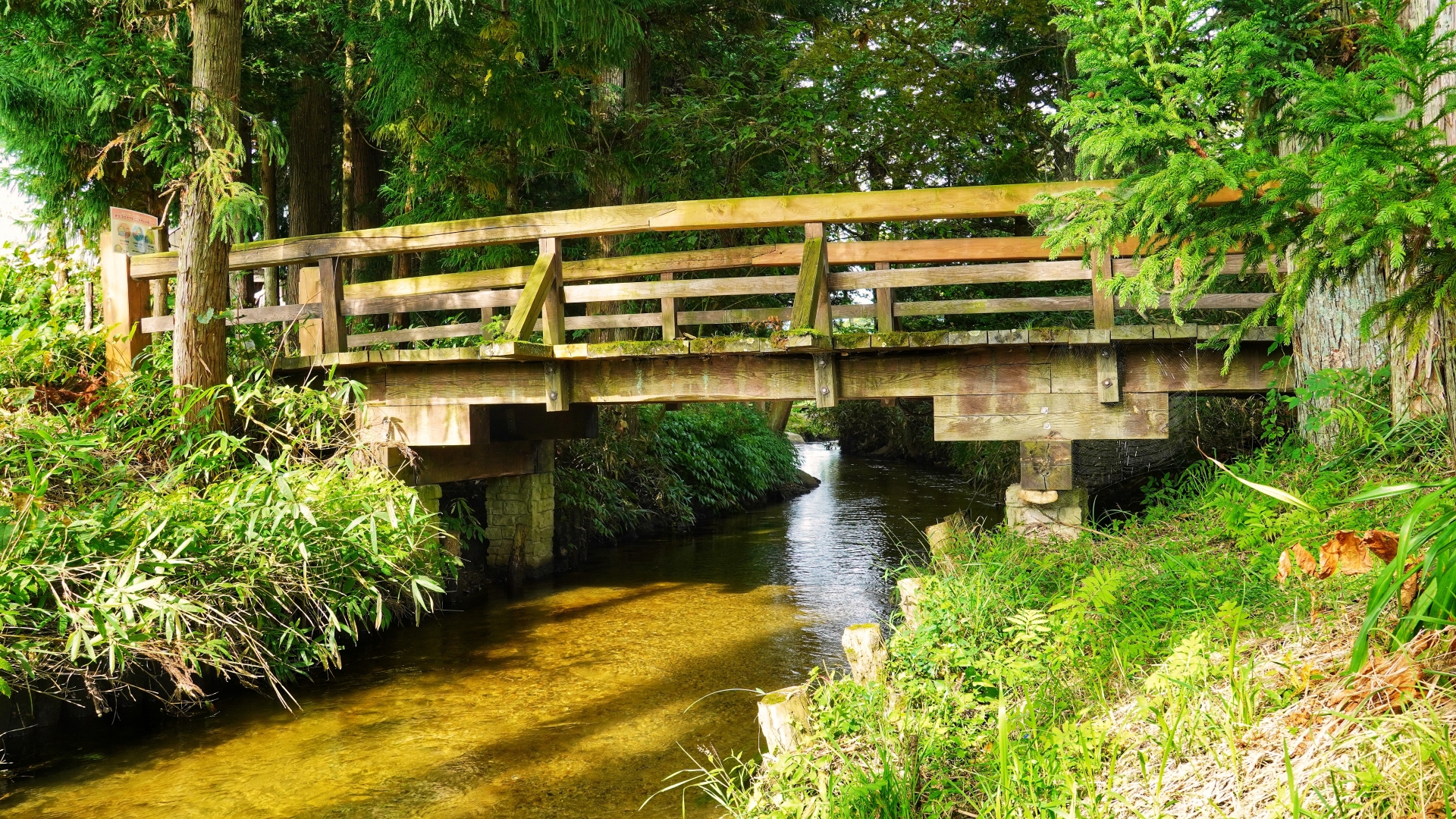
Nestled behind Jōkenji Temple—an ancient Soto Zen temple founded in 1490—lies the mysterious Kappa-buchi, a tranquil stream steeped in folklore and part of Tono’s cultural heritage. This spot is famously featured in the Tono Monogatari, where tales speak of mischievous kappa (water sprites) living in the rivers, pulling pranks on unsuspecting locals and even attempting to drag horses into the water. Today, the stream still exudes a slightly eerie charm, surrounded by lush vegetation that seems perfect for a kappa encounter. Along the bank, you’ll find kappa statues and a small shrine dedicated to the “Milk Goddess,” where women pray for healthy lactation by offering red cloth shaped like breasts. For those feeling adventurous, there’s even a 10 million yen reward for capturing a real kappa—but beware, you’ll need an official “Kappa Capture License” to try! These novelty licenses can be obtained at places like Michi-no-Eki Tono Kazenooka, Tabi no Kura Tono, or the Denshoen heritage park.
Denshoen 伝承園

Denshoen is a unique cultural park in Tono where visitors can immerse themselves in the world of traditional Japanese folktales. At its heart is the Kyū-Kikuchi-ke Jūtaku, a nationally designated Important Cultural Property—an L-shaped farmhouse (magariya) that offers a glimpse into the traditional life of farmers who lived alongside their horses. Inside, you’ll find authentic furnishings, farming tools, and a sunken hearth where you can listen to local storytellers share age-old legends. Another highlight is the Oshira-sama Hall, home to over a thousand figures of the silkworm deity Oshira-sama. According to local legend, Oshira-sama was born from the tragic love between a young girl and a horse—a story recounted in The Legends of Tono. Visitors can write wishes on cloth and dress an Oshira figure as part of a traditional prayer ritual.
The site also features a wooden warehouse called Itakura, filled with colorful and humorous displays about the Tono Monogatari and its famous creature, the kappa. After exploring, relax at the on-site eatery Oshira-tei, where you can enjoy hearty Tono dishes like hittsumi (hand-pulled dumplings in soup), keiran (sweet egg-filled mochi), and the adorable “Kappa-yaki,” a fish-shaped sweet snack. With its rich blend of folklore, history, and regional cuisine, Denshoen offers an unforgettable journey into the cultural heart of Tono.
Tono Folktale Museum とおの物語の館

Tono Folktale Museum is a cultural complex where visitors can immerse themselves in the rich folklore and traditions of Tono. Housed in a renovated sake brewery, the “Mukashibanashi-gura” offers an interactive experience of Japanese and Tono folktales through sound and visual storytelling. The facility also includes the Yanagita Kunio Exhibition Hall, dedicated to the author of The Legends of Tono, where you can learn about his life and the inspiration behind his work.
At “Tono-za,” storytellers bring local tales to life in the authentic dialect of the region. Visitors can also stop by the local produce and travel center, which offers souvenirs, farm stay reservations, and tour information. The former Takayoshi Ryokan, now the Yanagita Kunio Exhibition Hall, is a nationally designated Tangible Cultural Property and served as a base for folklorists like Yanagita, Shinobu Orikuchi, and Nevskiy. Additionally, Yanagita’s relocated retirement home—originally in Setagaya, Tokyo—is on display, offering further insight into his achievements and personal life.
Tsuzukiishi 続石
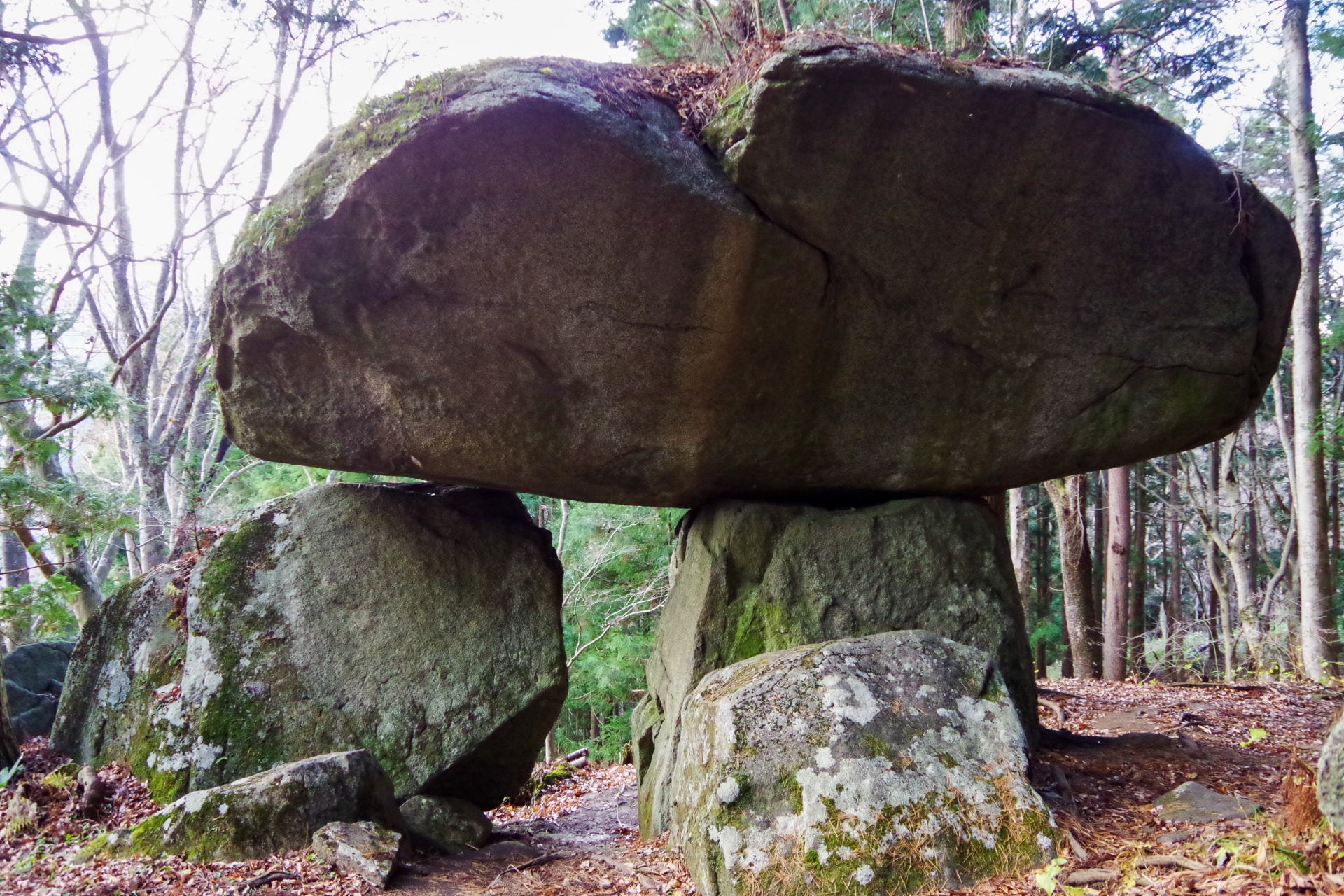
Tsuzukiishi is a mysterious megalithic formation deep in the mountains of Tono, resembling a stone torii gate. A massive capstone—about 7 meters wide, 5 meters deep, and 2 meters thick—rests precariously on just one of two upright stones, creating a stunning display of natural balance. Some say it is an ancient dolmen (a prehistoric burial site), while others believe it was stacked by the legendary warrior monk Benkei. The space beneath the capstone is large enough for an adult to pass through, adding to its allure.
Reaching Tsuzukiishi requires a 15-minute hike from the nearest parking area. As you step into the clearing where the rocks stand, the atmosphere shifts—you’re greeted by a sense of sacred stillness. Up close, the tiny gap between the stones is barely enough to slide a finger through, leaving many to wonder how such a massive rock came to rest so delicately atop another. While photos may not do it justice, seeing this natural marvel in person is truly worthwhile.
Tsuzukiishi is also steeped in legend. In the 91st tale of The Legends of Tono, a falconer who disturbed mountain deities playing at the site was thrown into a ravine and died shortly after. Another tale suggests Tsuzukiishi resembles a dolmen, with a stone large enough to span two supporting rocks and allow people to walk beneath, just like a torii. Please note that due to its mountain location, bears may be present—bring a bear bell and take proper precautions during your visit.
Roadside Station Tono Kaze-no-oka 道の駅 遠野風の丘
Roadside Station Tono Kaze-no-oka is a scenic roadside station just a 3-minute drive from Tono IC, fully renovated in April 2021. This rest stop offers a variety of services, including local travel and road information, dining, rest areas, and a well-stocked market featuring fresh produce and regional specialties.
At the food hall, visitors can enjoy delicious meals made with local ingredients unique to Tono. One highlight is the famous “Bucket Jingisukan” (grilled mutton served in a bucket), best enjoyed while taking in the peaceful countryside views from the observation deck. You’ll also find tasty local snacks (known as kobiru), handmade soba noodles, refreshing gelato, and soft-serve ice cream.
The market area is ideal for souvenir shopping, offering everything from fresh vegetables and traditional sweets to locally brewed beer and sake. Whether you’re just beginning your journey through Tono or looking for the perfect gift before heading home, Kaze no Oka is a perfect stop to experience the flavors and charm of the region.
Unedori Daimyojin Shrine 卯子酉様
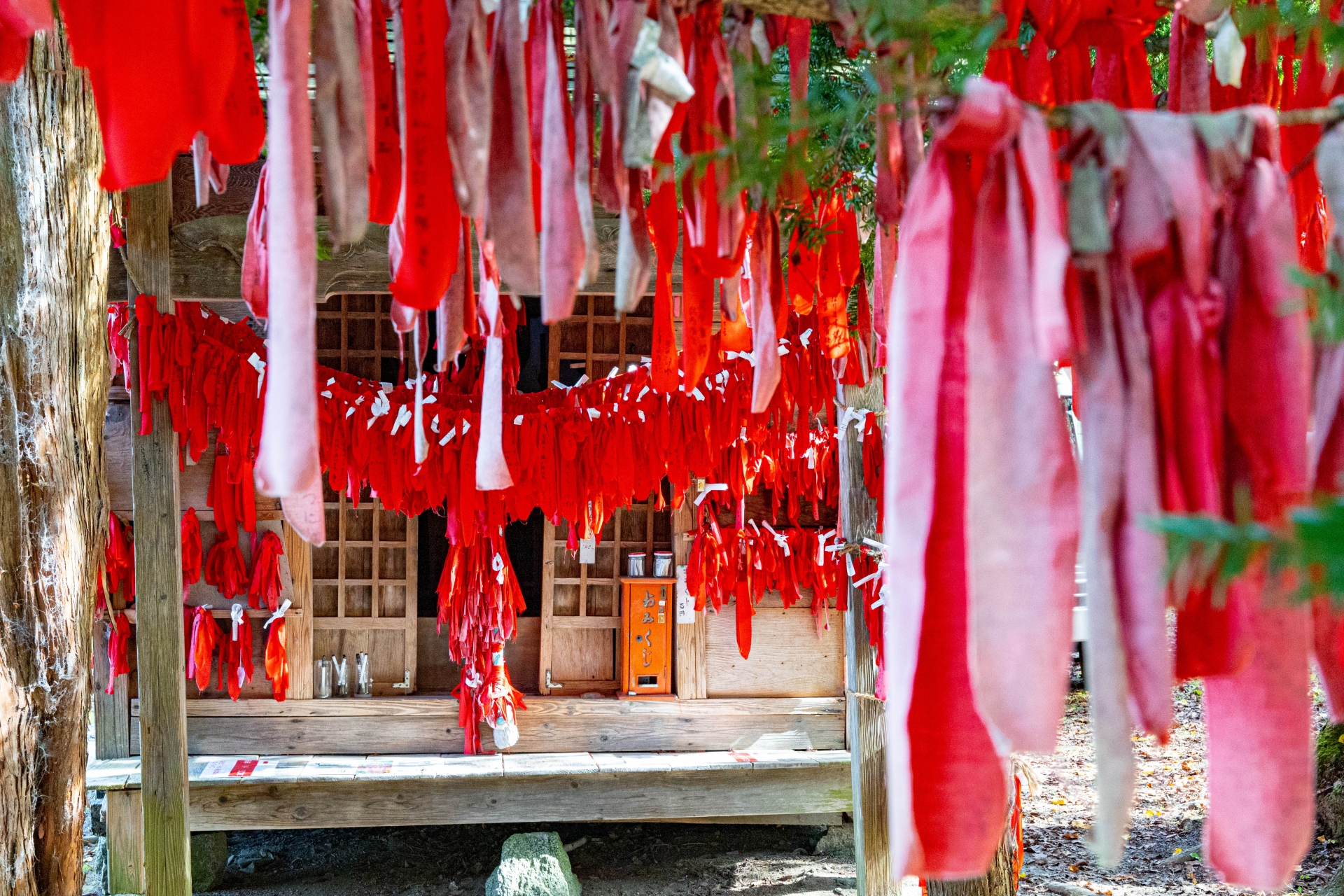
Unedori-sama is a small, sacred shrine nestled at the eastern foot of Mt. Atago in Tono, Iwate Prefecture, and is widely known as a “god of love.” Couples and those seeking romance often visit this tranquil site in hopes of having their wishes fulfilled. According to local tradition, if you can tie a red cloth—sold at the unmanned stall near the shrine—onto the tree using only your left hand, your romantic feelings will be returned.
Also called Unedori Daimeijin or Unedori Shrine, the site is steeped in legend. It is said that a mystical spirit once lived in a deep pool nearby and would grant the prayers of those who sincerely sought love, sometimes even appearing in person to devout worshippers. Today, the sight of red cloths fluttering among the tree branches adds a unique and heartfelt charm to this romantic destination.
Jokenji Temple 常堅寺

Jokenji Temple, founded in 1490, is a historic Soto Zen temple in Tono known not only for its spiritual significance but also for its charming local legends. Standing at the entrance are two imposing 3.5-meter Nio guardian statues. On the temple grounds, you’ll find a unique pair of guardian lion-dog statues known as the “Kappa Komainu.” One of them has a round depression on its head resembling the dish of a kappa—a mythical water creature from Japanese folklore. According to legend, a kappa who lived in the nearby stream helped extinguish a fire at the temple, earning its place as a revered protector.
Behind the temple flows a stream known as Kappa-buchi, believed to be inhabited by mischievous kappa in the past. Even today, the mossy banks and quiet waters give it an air of mystery. Near the stream stands a small shrine dedicated to the goddess of breastfeeding, where women offer red cloths shaped like breasts in hopes of increasing milk production. Inside the main hall, you’ll also find a wooden statue of Obinzuru-sama, said to relieve pain when you rub the corresponding part of the body. Jokenji offers a peaceful blend of history, folklore, and healing tradition, making it a must-visit spot in Tono.
Inariana Cave 稲荷穴
Inari Ana is a limestone cave located in the Shiraishi area along the upper reaches of the Tatsusobe River in Tono. Named after the nearby Inari Shrine, this mysterious cave stretches approximately 1,000 meters, though only about 180 meters have been fully explored. Known since ancient times, Inari Ana is especially famous for its crystal-clear spring water, which has been selected as one of the “Top 20 Famous Waters of Iwate.” Locals frequently visit the site to collect this pristine water.
In front of the cave stands a striking vermilion torii gate, adding a spiritual ambiance to the natural beauty of the area. The spring water flowing from the cave is also used to cultivate wasabi, and Tono proudly boasts the highest production volume of fresh wasabi in the Tohoku region. Each August, the local community hosts the Inari Ana Festival to celebrate this natural and cultural treasure. With nearby rest facilities and a campsite, Inari Ana is a serene destination where visitors can enjoy both nature and local tradition.
Tono City Museum 遠野市立博物館
The Tono City Museum is one of Japan’s leading museums dedicated to folklore, offering an immersive introduction to the world of The Legends of Tono through rich visual displays, dioramas, and authentic artifacts. The museum is divided into three themed exhibition rooms. In the first room, visitors can experience the mystical stories of Tono through multi-screen displays and projection mapping. The second room showcases the traditional lifestyles and culture of Tono’s people, divided into town, village, and mountain settings—complete with recreations of bustling markets and seasonal rural life. The third room features rotating special exhibitions held three to four times a year, ensuring that each visit offers something new to discover.
A major highlight is a multi-screen theater, where visitors can enjoy exclusive films based on local folktales, including rare animated works like Mizuki Shigeru’s Tono Monogatari and The Zashiki-warashi. Stunning footage of the sea of clouds over the Tono Basin further enhances the museum’s atmosphere of mystery and beauty. With its compelling mix of storytelling, visuals, and cultural artifacts, the Tono City Museum offers a deep and unforgettable journey into the heart of Japanese folklore.
Nabekura Park 鍋倉公園

Nabekura Park is a scenic and historically rich site located on Mt. Nabekura (344 meters high) at the southern edge of Tono City. Once the location of Nabekura Castle—originally called Yokota Castle—this mountaintop fortress was established in the late 16th century by Hirozato Asonuma and later became the stronghold of the Nanbu clan, who ruled the region for over 250 years. Though the castle was dismantled in 1869 during the Meiji Restoration, its grounds remain well-preserved as one of the finest examples of a medieval mountain castle in Iwate Prefecture. In recognition of its historical significance, the site was designated a National Historic Site in 2023.
Today, the site is known as Nabekura Park and serves as a beloved local recreation area. The former Sannomaru (third bailey) now features an observation deck modeled after a castle keep, offering sweeping views of the city. In spring, the park is especially popular for its cherry blossoms, with Somei Yoshino and wild mountain cherries in full bloom. The Ninomaru area also houses the Nanbu family cemetery. Visitors can learn more about the castle’s legacy at the nearby Tono Municipal Museum, where special castle seals (Gojoin) are available. Please note that access roads and facilities may be closed during winter months.
Megane Bridge めがね橋

The Miyamori River Bridge—locally known as the “Megane Bridge” or “Spectacle Bridge” for its five elegant arch spans—is one of the most iconic landmarks of Miyamori Town, serving as the western gateway to Tono. Completed in 1943, the bridge stretches 107.3 meters long and rises 20.6 meters high, with five arches evenly spaced at 20-meter intervals. In front of the bridge, visitors can still see the red-brick pillars from an earlier iron bridge built in 1915 for the Iwate Light Railway, adding a touch of historical charm.
The bridge is especially stunning at dusk, when it is illuminated by LED lights—an initiative started by the local chamber of commerce in 1991. Its enchanting nighttime glow has earned it recognition as a “Lover’s Sanctuary,” complete with romantic monuments nearby. The Megane Bridge also has a literary connection: it is said that the renowned children’s author Kenji Miyazawa drew inspiration from the Iwate Light Railway, which once ran over this bridge, for his beloved story Night on the Galactic Railroad. Whether you’re a history buff, photography enthusiast, or couple seeking a romantic moment, the Megane Bridge offers a magical experience unlike any other.
Kamaishi: A Coastal City of History and Resilience
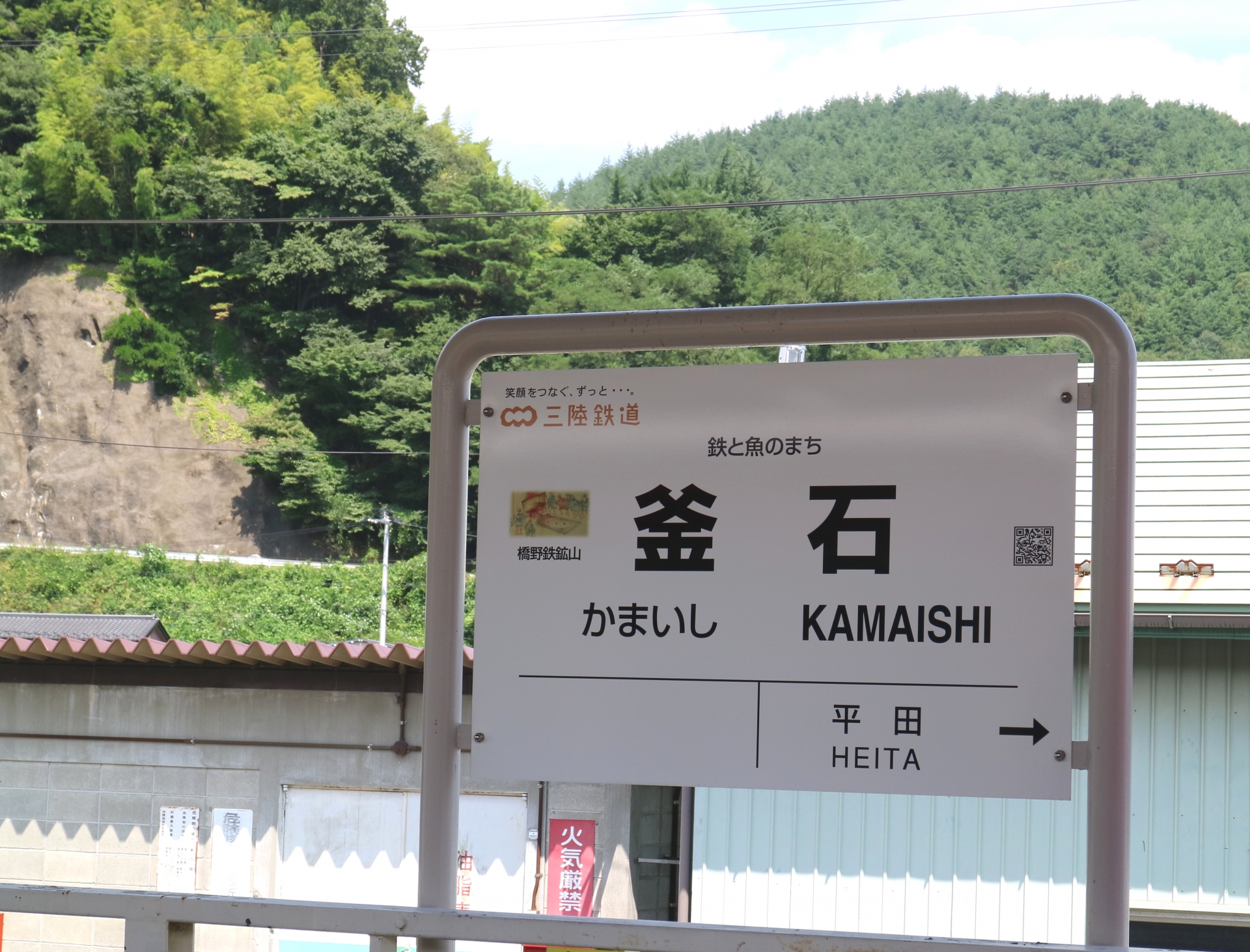
Located on the scenic Sanriku Coast of Iwate, Kamaishi is known as the birthplace of Japan’s modern iron industry and home to a UNESCO World Heritage site. The city offers dramatic ocean views, fresh seafood, and cultural landmarks like the towering Kamaishi Daikannon statue. After rebuilding from the 2011 tsunami, Kamaishi now stands as a symbol of resilience and hope—welcoming visitors with a unique blend of history, nature, and heart.
Kamaishi Dai-kannon Temple 釜石大観音
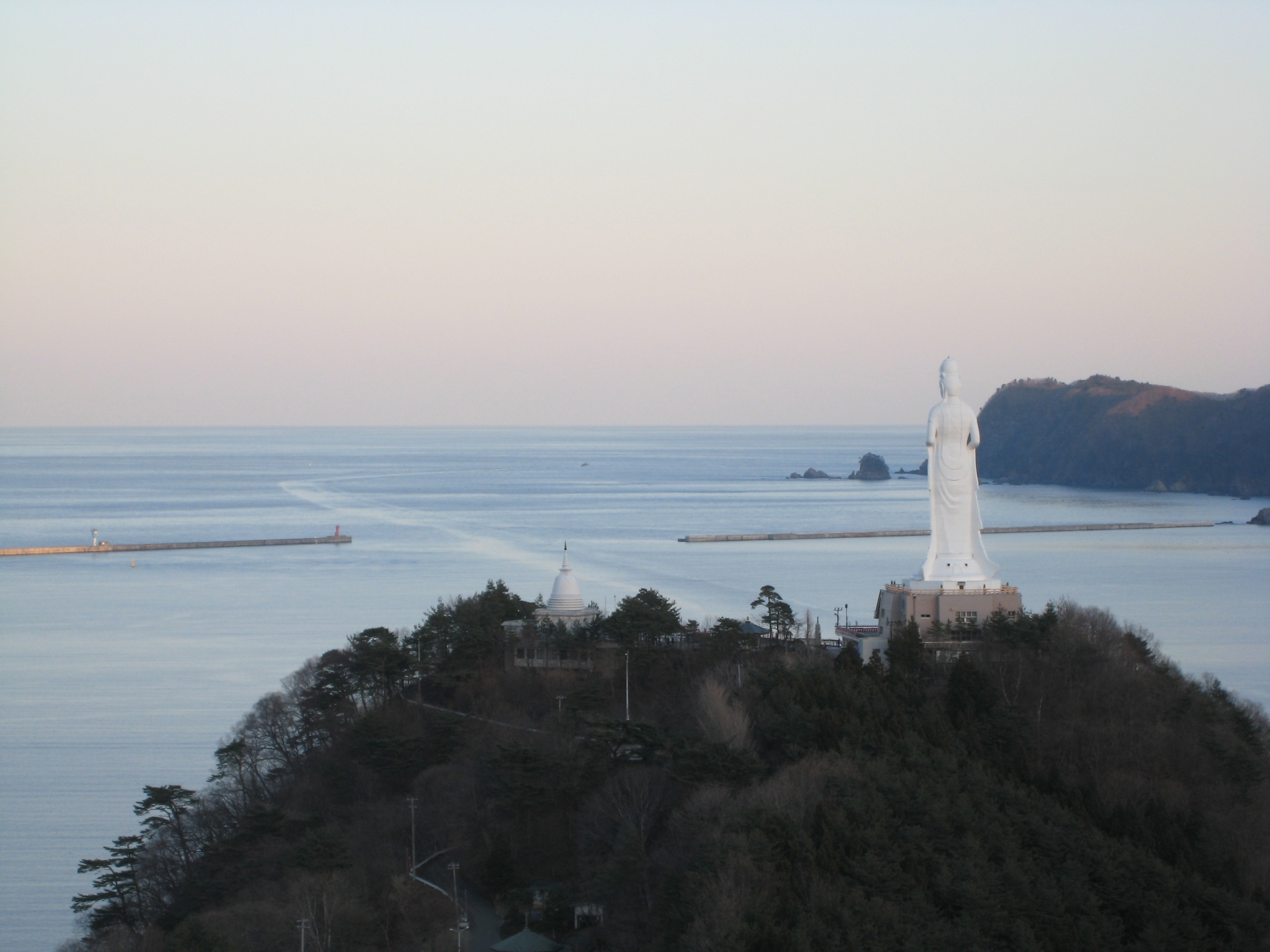
Kamaishi Daikannon is a towering 48.5-meter white statue of the Fish Basket Kannon, built to honor the souls of those lost in natural disasters and to bring peace and fulfillment to the living. Located in Kamaishi, Iwate Prefecture, this 12-story sacred site features not only the impressive statue holding a fish, but also a stupa enshrining the Buddha’s relics and a hall dedicated to Fudo Myo-o. Visitors can explore the inside of the statue, which houses 33 Kannon statues and the Seven Lucky Gods. From the observation decks on the 11th and 12th floors, you can enjoy breathtaking views from an altitude of 120 meters above sea level. Kamaishi Daikannon was designated a “Lover’s Sanctuary” in 2016 as a romantic spot perfect for proposals. A heart-shaped monument and “Bell of Wishes,” designed by a local woman and adorned with seagulls symbolizing the port town of Kamaishi, now welcome visitors wishing for love and happiness. This unique site blends spiritual heritage with romantic charm, making it a memorable destination for travelers.
Sennin Pass 仙人峠

Located on National Route 283 at the border between Tono and Kamaishi, the scenic Sennin Pass sits at an elevation of 887 meters within the lush Kitakami Mountain Range. Before the opening of the Sennin Tunnel in 2007, the old loop road with its sharp curves and steep slopes was considered a challenging route. Today, the former road on the Kamaishi side has become a popular driving course that immerses visitors in the remote beauty of the mountains. Renowned for its fresh greenery in spring and vibrant autumn foliage, the pass is especially breathtaking from late October to early November, when the colorful leaves create a vivid natural tapestry right before your eyes.
Hashino Iron Mining and Smelting Site 橋野鉄鉱山(史跡 橋野高炉跡)
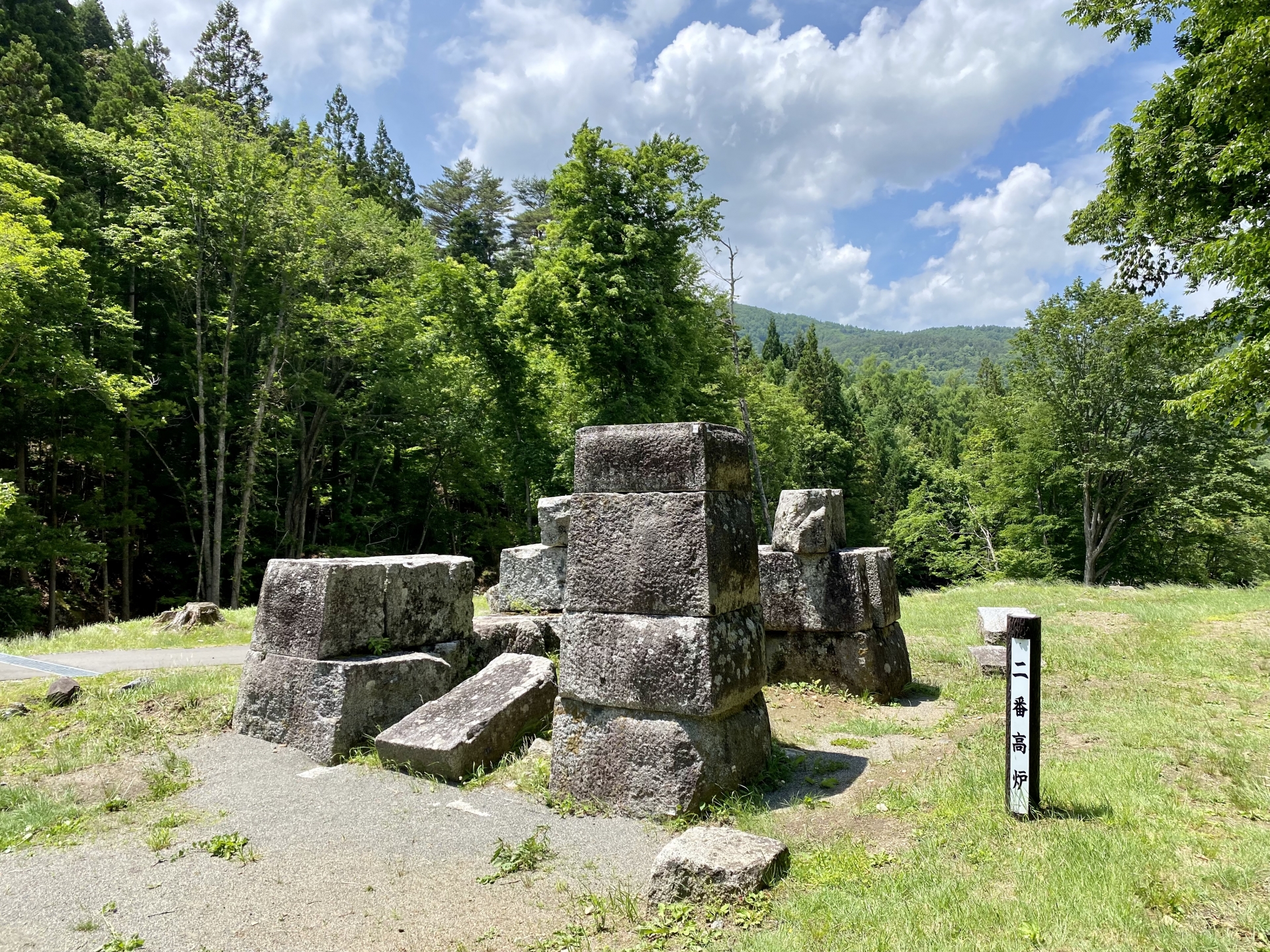
Nestled in the mountains of Kamaishi, the Hashino Iron Mining and Smelting Site is home to Japan’s oldest surviving Western-style blast furnace and represents the birthplace of modern iron manufacturing in the country. Built in the late Edo period to produce iron cannons capable of rivaling Western firepower, the blast furnace at Hashino played a crucial role in Japan’s early industrialization. Under the leadership of engineer Takato Oshima, continuous smelting (pig iron production) was successfully achieved here in 1857. The site includes remnants of the full iron-making process—from ore mining and transportation routes to the blast furnace ruins and charcoal production—making it a rare, well-preserved example of a historical industrial system.
Recognized for its contribution to Japan’s modernization, Hashino was designated a National Historic Site in 1957 and later inscribed as part of the UNESCO World Heritage Site “Sites of Japan’s Meiji Industrial Revolution” in 2015. Today, visitors can explore the atmospheric forested area, trace the legacy of pioneering industrial efforts, and witness how natural resources and traditional craftsmanship fueled Japan’s transformation into a modern nation. Guided tours and educational exhibits further offer a glimpse into the daily life and ingenuity of those who once worked in this “Iron City” of over 150 years.
Senjojiki 御箱崎(千畳敷)
Located at the tip of the Hakozaki Peninsula, Senjojiki is a stunning natural viewpoint offering dramatic coastal scenery and a sense of untouched wilderness. The name “Senjojiki” refers to the vast granite rock formations said to be wide enough to spread out a thousand tatami mats. From here, visitors are treated to a breathtaking view of Sankan Island, a designated Natural Monument of Japan. The 6.8 km walking trail from Hakozaki Shirahama to the lighthouse at the peninsula’s end offers refreshing sea breezes, panoramic vistas, and encounters with unique geological formations, making it a highlight of the Michinoku Coastal Trail and a key attraction within the Sanriku Geopark.
Please note that the path leading down to Senjojiki is unpaved and can be steep, so caution is advised. The area is surrounded by cliffs and the sea—be especially careful near the shoreline. Along the trek, you’ll pass the vibrant red torii gate of Ohakozaki Shrine, the scenic Ohakozaki Lighthouse, and catch views of the uninhabited Sankan Island, a nationally protected bird sanctuary. Though the route includes unmarked sections and rugged terrain, guided tours are available to ensure a safe and rewarding adventure.
Iron History Museum 釜石市立鉄の歴史館
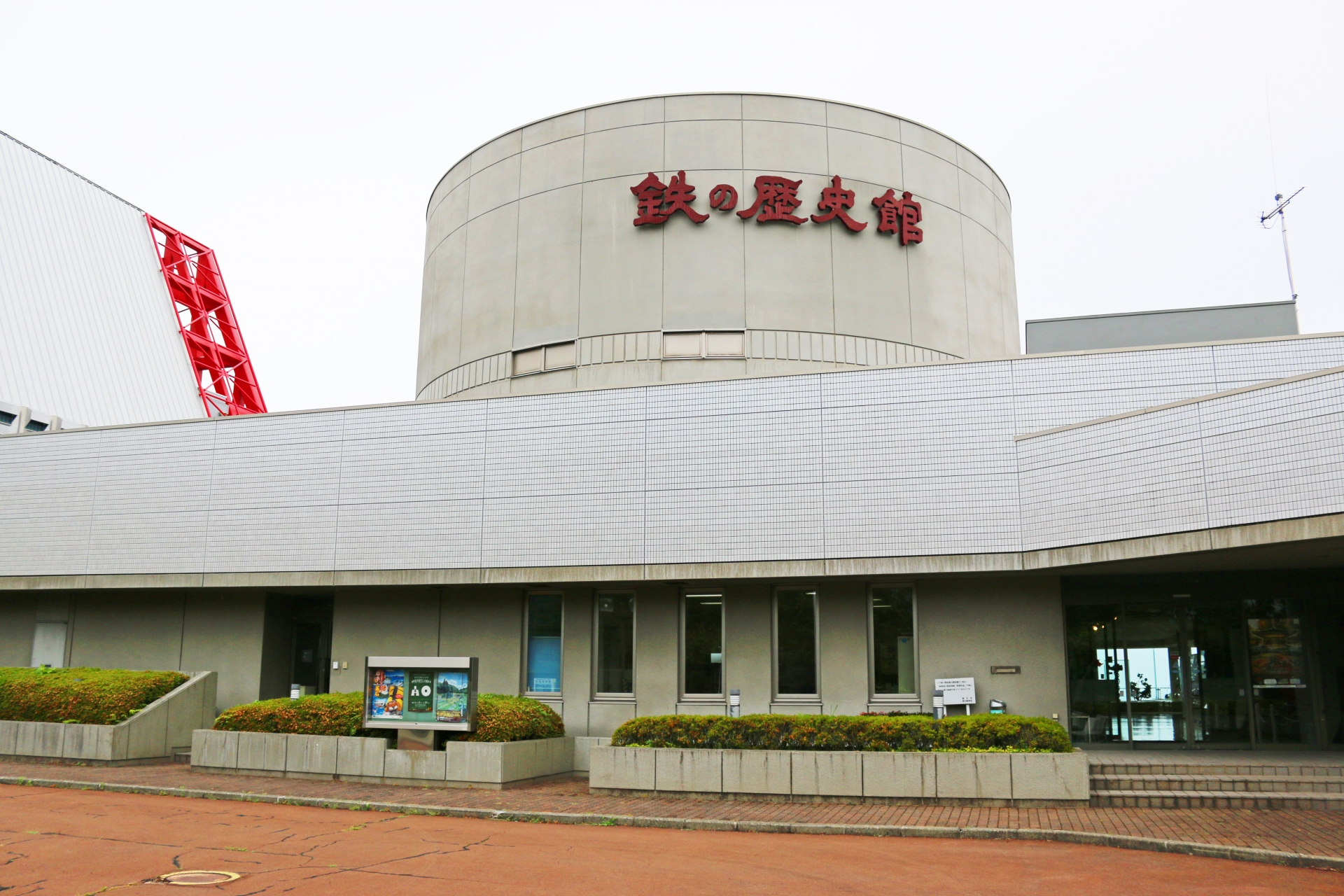
The Iron History Museum in Kamaishi is one of the few museums in Japan dedicated entirely to the story of iron. It offers a fascinating journey through the origins of iron-making, the arrival of iron culture in Japan, the development of Western-style blast furnaces, and the lives of the people who shaped the industry. A highlight is the life-sized replica of the No.3 blast furnace from the historic Hashino Iron Mine, brought to life through an immersive multi-image theater experience. Visitors can also try hands-on metal casting workshops (advance reservation required).
Outside the museum, you’ll find a preserved C20-type mini steam locomotive, once used on the Kamaishi Railway—the third railway to open in Japan—for transporting iron ore. From the museum hall, enjoy sweeping views of Kamaishi Bay and the towering Kamaishi Daikannon statue. You can also explore a miniature model of the Kamaishi Bay Breakwater, recognized by Guinness World Records as the world’s deepest at 63 meters. Don’t miss the impressive replica of a giant ammonite fossil (12 x 16 meters), a gift from Kamaishi’s sister city, Digne-les-Bains in France.
gourmet delights|Sanriku Kaihouzuke 海宝漬 中村家
Just a 4-minute walk from JR Kamaishi Station, this specialty shop offers one of Kamaishi’s most famous gourmet delights: Sanriku Kaihouzuke. This best-selling seafood delicacy combines locally harvested Sanriku mekabu seaweed marinated in a secret sauce, tender abalone simmered using a unique “damashi-ni” technique, and a rich topping of salmon roe (ikura). The result is a luxuriously thick, flavorful dish that pairs perfectly with freshly steamed white rice. The shop also features other popular items like Hotate Ougonzuke—soy-marinated mekabu with sake-steamed scallops and ikura—and Hotate Kazunoko Ougonzuke, which includes crunchy herring roe for added texture. It’s a must-visit for those eager to taste the rich bounty of Sanriku’s coastal waters.
Roadside Station Kamaishi Sennin Toge 道の駅 釜石仙人峠

Located at a key junction between Kamaishi and Tono, the Roadside Station Kamaishi Sennin Toge is a convenient rest stop offering local charm and flavors. Inside, you’ll find a variety of souvenirs and fresh seafood products unique to Kamaishi. The station is also known for its popular light meals, including its original Kamaishi Ramen, a local favorite with a simple yet flavorful broth. For a sweet treat, don’t miss the Touyu Soy Sauce Soft Serve, a soft-serve ice cream infused with locally brewed soy sauce for a surprisingly rich and savory twist. It’s the perfect place to relax, refuel, and take home a taste of the region.
San Fish Kamaishi サン・フィッシュ釜石
San Fish Kamaishi is a vibrant commercial complex conveniently located just steps from JR Kamaishi Station. This lively marketplace features a variety of shops such as Tosen Gyoten and Shichibeeya Shoten, offering a wide selection of fresh seafood from the Sanriku coast—including locally caught salmon and donko—as well as dried fish, bottled delicacies, and other processed marine products. The facility also houses numerous eateries where visitors can enjoy seafood rice bowls generously topped with ikura (salmon roe) and uni (sea urchin), as well as local favorites like Kamaishi Ramen. Connected by a walkway to the nearby Sea Plaza Kamaishi, it’s the perfect one-stop destination for tasting regional flavors and picking up souvenirs.
Miyako: Nature and Tradition on Iwate’s Coast

Miyako City offers breathtaking coastal scenery, including the iconic Jōdogahama Beach with its white rocks and clear blue sea. Known for fresh seafood, boat cruises, and rich local traditions, Miyako is a perfect blend of natural beauty and cultural depth. A symbol of resilience, the city welcomes visitors with warmth and unforgettable views of the Sanriku Coast.
The Sanriku Railway 三陸鉄道
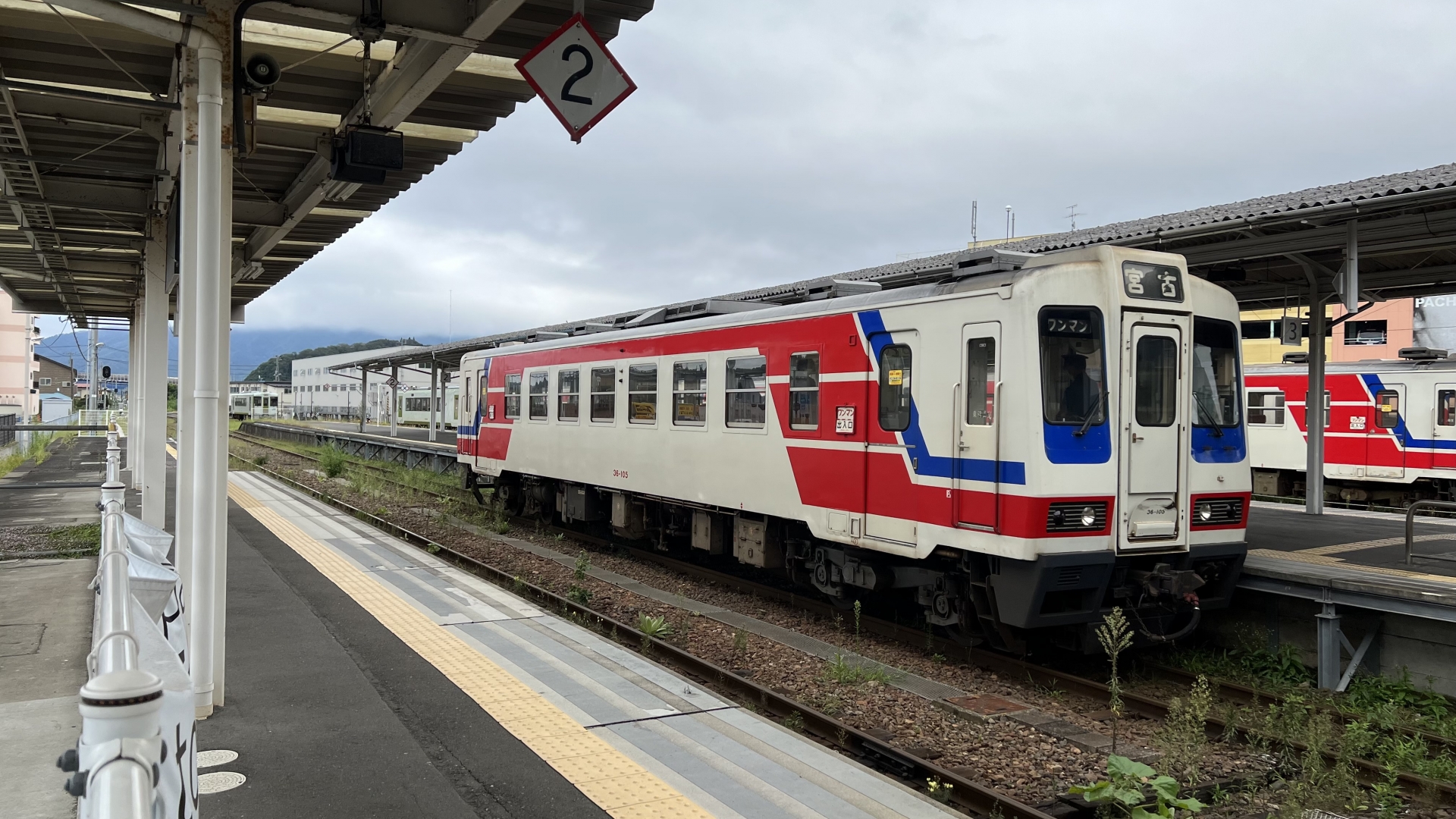
The Sanriku Railway is a beloved local train line that runs along the scenic Sanriku coastline in Iwate Prefecture. Since its opening in 1984, it has captured the hearts of both locals and visitors from across Japan. Known for its charming rural stations and retro-style trains, the railway has frequently appeared in popular TV dramas. One of its most unique attractions is the “Kotatsu Train,” operating during the winter season, where passengers can enjoy breathtaking coastal views while staying warm under traditional Japanese heated tables. It’s a memorable way to experience the beauty and hospitality of the Sanriku region.
Jodogahama 浄土ヶ浜
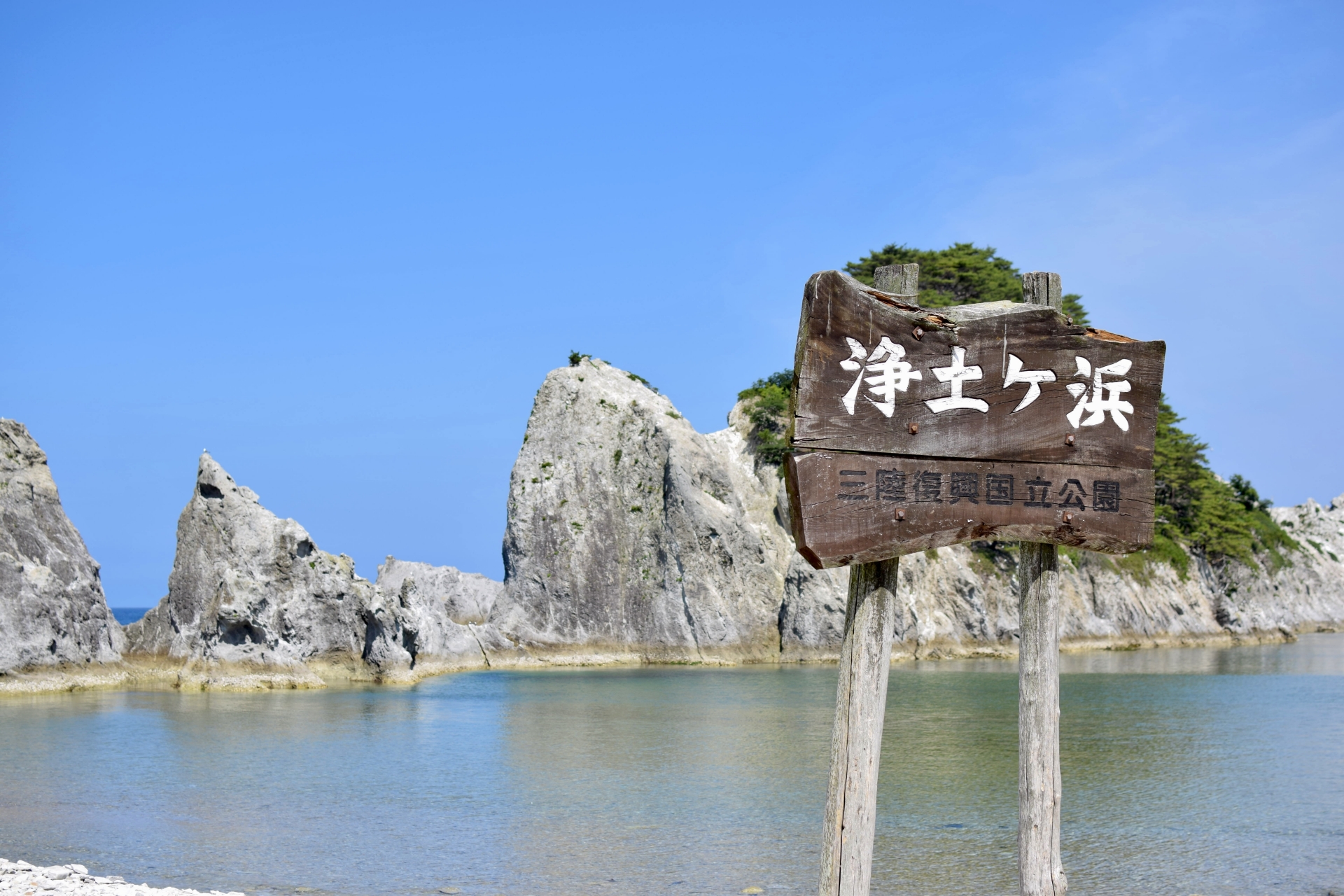
Jodogahama, located in Iwate Prefecture, is one of the region’s most iconic scenic spots, celebrated for its striking natural beauty. Its name, meaning “Pure Land Beach,” comes from its resemblance to the Buddhist paradise, a comparison first made centuries ago. Visitors are captivated by the dramatic contrast between the rugged white rock formations, sculpted by nature over time, and the crystal-clear emerald green waters. This breathtaking landscape offers a serene and otherworldly atmosphere, making Jodogahama a must-visit destination along the Sanriku Coast.
Mystical Blue Grotto at Jodogahama, Sanriku Fukko National Park 青の洞窟
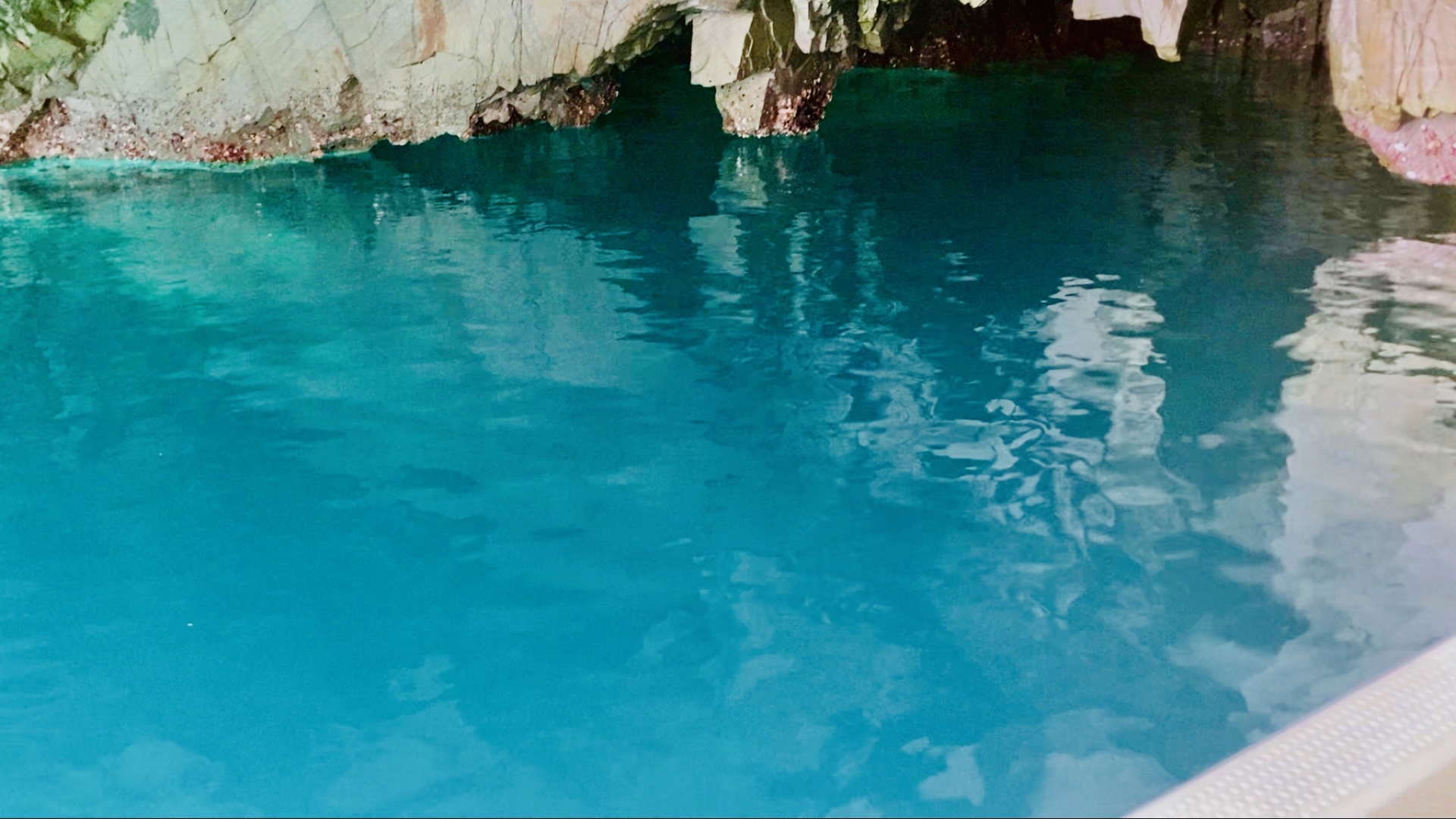
Nestled within the scenic coves of Jodogahama in Miyako City, the Jodogahama Marinehouse offers a magical boat experience unlike any other. Hop aboard a traditional sappa-bune (small fishing boat) and venture into the legendary “Blue Grotto”—a sea cave known for its shimmering blue waters illuminated by sunlight. Along the way, you’ll pass striking coastal formations like Ken-no-Yama and Chi-no-Ike, each with its own folklore. The tour also offers breathtaking views of rare geological features such as tafoni (honeycomb rock formations) carved over millions of years. With calm waters, playful black-tailed gulls, and a touch of mystery, this 20-minute cruise is a must for nature lovers and adventurers alike. Operated from March to November, this unforgettable ride invites you to witness the serene beauty and storytelling spirit of Sanriku’s coast.
Candle Rock ローソク岩

Rōsoku-iwa, or “Candle Rock,” is a striking natural formation located along the Ōsawa Coast, just north of Jodogahama in Iwate Prefecture. Standing 40 meters tall, this towering igneous rock appears as though it pierced through the surrounding strata, with its exposed vertical dike clearly visible—a rare geological phenomenon. Recognized as both a National Natural Monument and part of the Sanriku Geopark, Rōsoku-iwa is inaccessible from land. To view its dramatic form up close, visitors can take the Miyako Jodogahama Sightseeing Boat, which offers an unforgettable experience along the Sanriku coastline.
Miyako Fish and Vegetable Market 宮古市魚菜市場
Miyako Fish and Vegetable Market is a lively local marketplace in Miyako City, known as the “kitchen of the community.” From early morning, the market offers a wide variety of fresh seafood, locally processed marine products, and seasonal produce grown by local farmers. You’ll also find vibrant flowers and other regional specialties. It’s not only a great spot to experience the local food culture, but also a place of warm community interaction. Visitors can have their purchases packed and shipped, making it a convenient stop for picking up souvenirs.
Sanno Rock 三王岩

Sanno Rock (Sanno-iwa), located within the Sanriku Fukko National Park, is one of the most iconic and popular rock formations in the region. The striking trio consists of the central “male rock” flanked by the “female rock” and “drum rock,” forming a unique and picturesque landscape. Designated as a Natural Monument of Iwate Prefecture, these rocks can be admired from nearby viewpoints, including the Sanno Park parking area and a scenic trail. Please note that parts of the walking path remain closed due to damage from the Great East Japan Earthquake.
Gourmet:Juwari Soba Takaraya 十割そば たからや
“Juwari Soba Takaraya” is a traditional soba restaurant located in Miyako City, offering a true taste of the region’s culinary heritage. Specializing in stone-ground 100% buckwheat soba noodles (juwari soba), the restaurant takes pride in its commitment to quality and authenticity. Each dish reflects the harmony between classic Japanese soba-making techniques and locally sourced ingredients, delivering a rich and satisfying dining experience rooted in the flavors of Miyako.
Hidejima 日出島
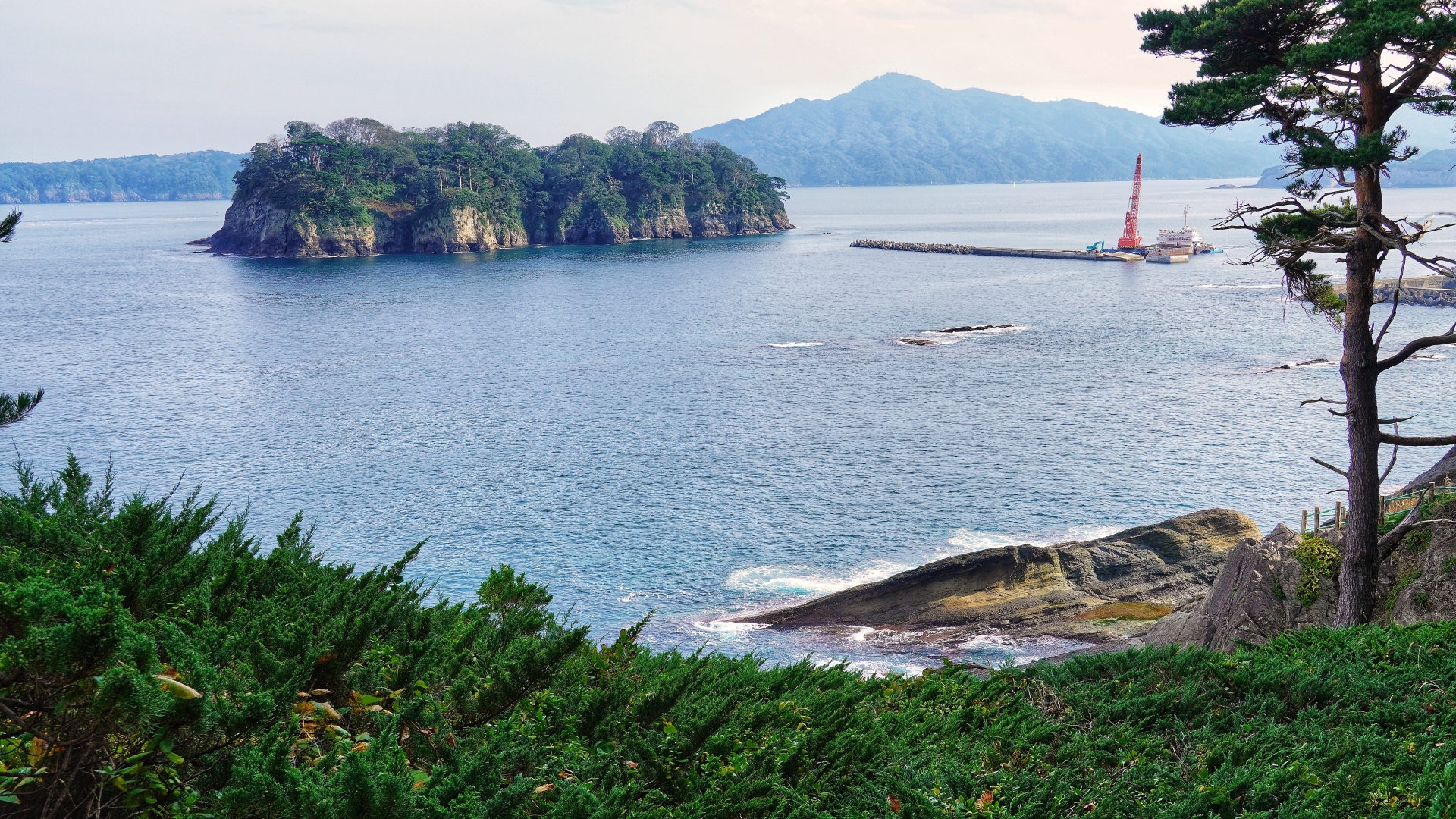
Hidejima is a small island located just east of the Hidejima settlement, with a circumference of about 1.8 kilometers. Its name, meaning “Sunrise Island,” comes from the view of the sun rising directly behind it when seen from the nearby village. The island is home to Japan’s largest breeding colony of the rare and endangered Tristram’s Storm Petrel (Kurokosijiro-umitsubame), making it a designated National Natural Monument and part of the Sanriku Geopark. Landing on the island is prohibited to protect the wildlife, but visitors can admire its natural beauty and ecological significance from sightseeing or fishing boats.
Shiofuki-ana 潮吹穴
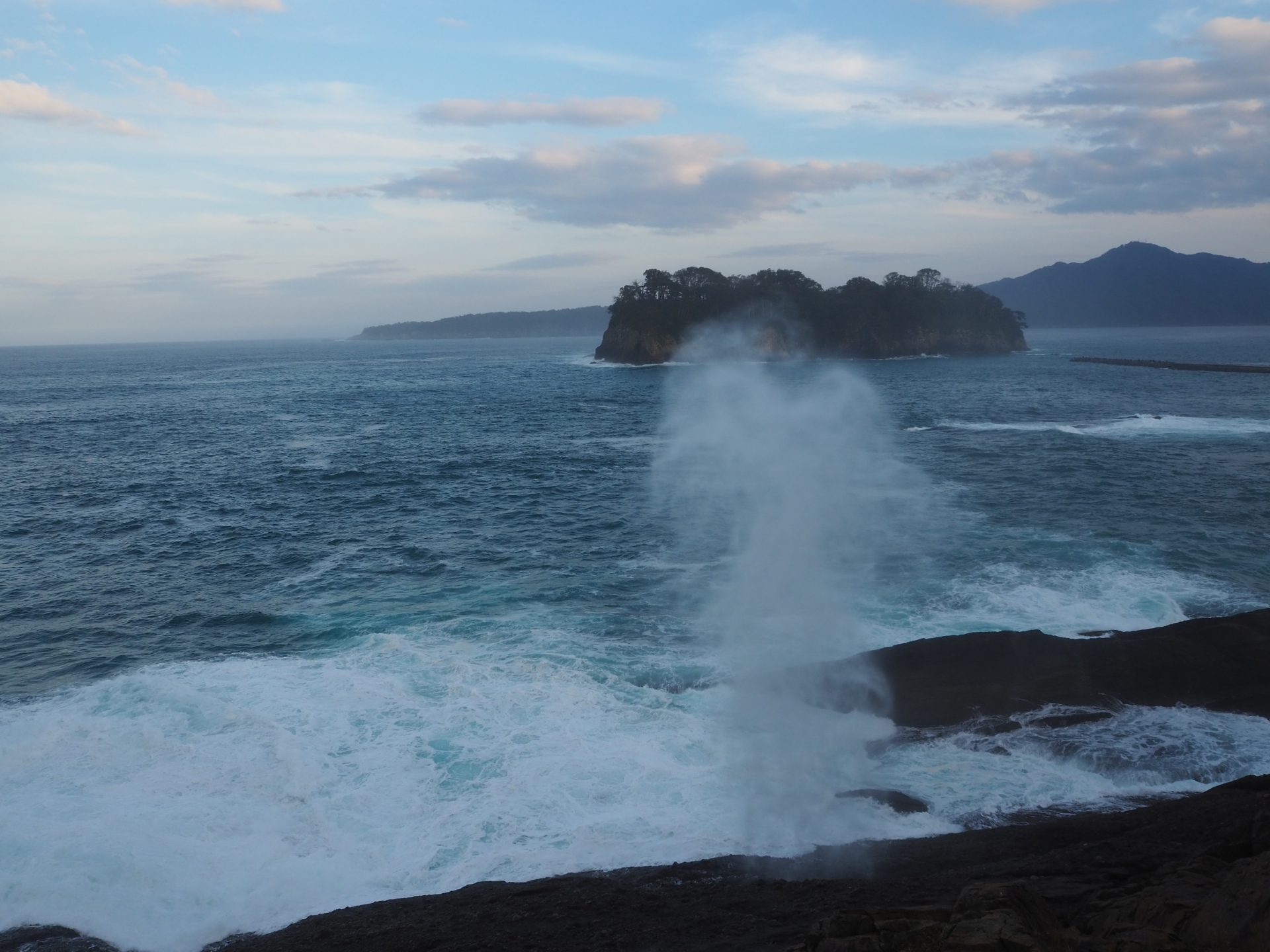
The Shiofuki-ana, or “Blowhole,” is a dramatic natural phenomenon located along the coast between the Hidejima area and Kyukamura Rikuchu-Miyako, just north of Jodogahama. Formed by wave erosion, this sea cave connects to the surface through a narrow opening. When large waves crash into the cave, seawater is forced up and shoots out with great force. Depending on the wave conditions, the spray can reach up to 30 meters high, especially during rough seas and strong northeasterly winds—an awe-inspiring sight. Recognized as one of Japan’s largest blowholes, it was designated a National Natural Monument in 1939 and certified as part of the Sanriku Geopark in 2013. The blowhole is formed from conglomerate rock layers deposited around 100 million years ago, shaped by freshwater flow and seawater erosion. Please note: the blowhole may not be active during calm sea conditions.



